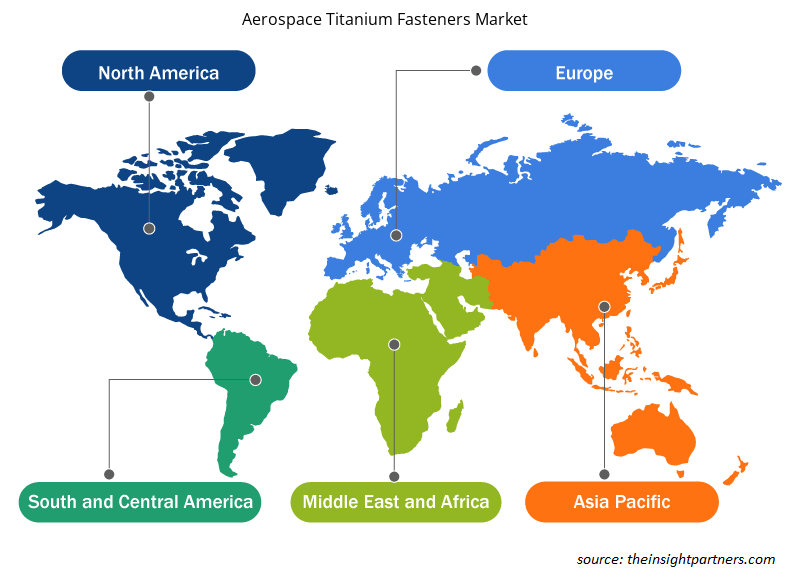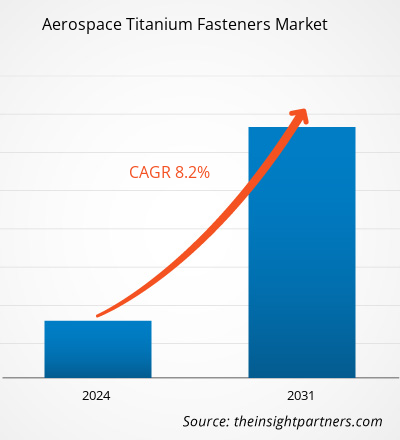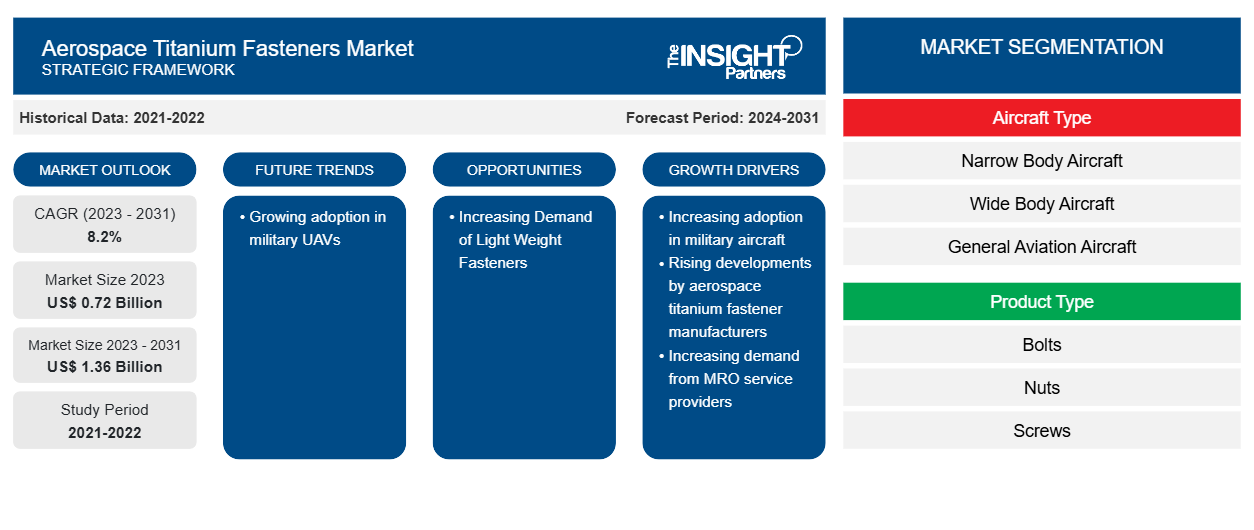Der Markt für Titanbefestigungen für die Luft- und Raumfahrt wird voraussichtlich von 0,72 Milliarden US-Dollar im Jahr 2023 auf 1,36 Milliarden US-Dollar im Jahr 2031 anwachsen. Der Markt wird zwischen 2023 und 2031 voraussichtlich eine durchschnittliche jährliche Wachstumsrate von 8,2 % verzeichnen. Die zunehmende Verbreitung militärischer Drohnen dürfte ein wichtiger Trend auf dem Markt bleiben.
Marktanalyse für Titanbefestigungen für die Luft- und Raumfahrt
Zu den wichtigsten Akteuren auf dem globalen Markt für Titanbefestigungen für die Luft- und Raumfahrtindustrie gehören LISI Aerospace, Apollo Aerospace Components Limited, Howmet Aerospace Inc, KLX Inc und 3V Fasteners. Der Markt ist fragmentiert, da eine große Anzahl von Akteuren die inländische und internationale Nachfrage bedient. Die Unternehmen bedienen ständig die Nachfrage ihrer jeweiligen regionalen Flotten, was das Wachstum für Titanbefestigungen in der Luft- und Raumfahrtindustrie weiter vorantreibt.
Marktübersicht für Titanbefestigungen für die Luft- und Raumfahrt
Das Ökosystem des Marktes für Titanbefestigungen für die Luft- und Raumfahrt ist vielfältig und entwickelt sich ständig weiter. Seine Interessenvertreter sind Rohstofflieferanten, Hersteller von Titanbefestigungen für die Luft- und Raumfahrt und Endverbraucher. Wichtige Akteure besetzen verschiedene Knotenpunkte des Marktökosystems. Rohstofflieferanten liefern Materialien an Hersteller von Befestigungselementen, die diese dann zur Herstellung und Konstruktion der Endprodukte verwenden. Das Endprodukt wird dann über verschiedene Kanäle an Flugzeughersteller, Komponentenhersteller und MRO-Anbieter geliefert, beispielsweise über Direktverkäufe über Unternehmensvertriebshändler oder Drittverkäufe über Drittvertriebshändler. Flugzeug-OEMs oder Komponentenhersteller integrieren dann Befestigungsprodukte in ihre jeweiligen Montageprodukte.
Passen Sie diesen Bericht Ihren Anforderungen an
Sie erhalten kostenlose Anpassungen an jedem Bericht, einschließlich Teilen dieses Berichts oder einer Analyse auf Länderebene, eines Excel-Datenpakets sowie tolle Angebote und Rabatte für Start-ups und Universitäten.
-
Holen Sie sich die wichtigsten Markttrends aus diesem Bericht.Dieses KOSTENLOSE Beispiel umfasst eine Datenanalyse von Markttrends bis hin zu Schätzungen und Prognosen.
Treiber und Chancen auf dem Markt für Titanbefestigungen für die Luft- und Raumfahrt
Steigende Nachfrage von MRO-Dienstleistern
Die Wartungs-, Reparatur- und Überholungsvorgänge (MRO) umfassen regelmäßige Inspektionen, Fehlerbehebungen, Überholung, Austausch und die Durchführung von Flugzeugmodifikationen zur kontinuierlichen Lufttüchtigkeit eines Flugzeugs und seiner Teile. Flugzeuge werden regelmäßig gewartet, wobei verschiedene Luft- und Raumfahrtteile wie Fahrwerk und Triebwerk ausgetauscht und repariert werden, damit das Flugzeug optimal funktioniert. Die steigenden MRO-Ausgaben für Militär- und Verkehrsflugzeuge treiben daher das Wachstum des Marktes für Titanbefestigungen für die Luft- und Raumfahrt voran. So vergab Sichuan Airlines im März 2021 einen fünfjährigen MRO-Dienstleistungsvertrag an MTU Maintenance für seine Flugzeuge A319, A320 und A321. Im April 2021 verlängerte IndiGo Airlines seinen MRO-Vertrag mit Air France Industries KLM Engineering & Maintenance für seine A320-Flotte. Darüber hinaus haben andere Entwicklungen in den Jahren 2022 und 2023 im Zusammenhang mit den vertragsbasierten MRO-Aktivitäten in verschiedenen Regionen den Markt für Luft- und Raumfahrtbefestigungen in verschiedenen Regionen in der Vergangenheit angetrieben. Darüber hinaus dürfte das Wachstum im Flugzeug-MRO-Sektor auch in den kommenden Jahren den Markt für Titanbefestigungen für die Luft- und Raumfahrt ankurbeln.
Steigende Nachfrage nach leichten Verbindungselementen
Die globalen Akteure der Luftfahrtindustrie legen Wert auf die Herstellung, Integration oder Montage von Leichtbaumaterialien an Flugzeugmodellen. Die Luftfahrtbehörden, Flugzeughersteller, Hersteller von Flugzeugkomponenten, MRO-Dienstleister und Streitkräfte suchen nach Leichtbaumaterialien für jede Komponente, um die Flugreichweite des Flugzeugs zu erhöhen und die Treibstoffeffizienz zu steigern. Titanlegierungen sind zu einem unverzichtbaren Strukturmaterial für die Zivilluftfahrt geworden, da sie von fortschrittlichen Herstellern ziviler Flugzeuge in großem Umfang eingesetzt werden. Außerdem gibt es derzeit viele Anwendungen für Titanbefestigungen bei der Herstellung von Flugzeugen. Zu den Anwendungen von Titanbefestigungen in Flugzeugen gehören beispielsweise Fahrwerke, Düsentriebwerke, Lüfterblätter, Flügel, Propeller, Flugzeugzellen und verschiedene Arten von Wellen. Darüber hinaus dürften die erwarteten zukünftigen Auslieferungen von rund 40.000 Verkehrsflugzeugen bis Ende 2042 in den kommenden Jahren neue Möglichkeiten für Marktanbieter schaffen.
Segmentierungsanalyse des Marktberichts zu Titanbefestigungen für die Luft- und Raumfahrt
Wichtige Segmente, die zur Ableitung der Marktanalyse für Titanbefestigungen für die Luft- und Raumfahrt beigetragen haben, sind Flugzeugtyp, Produkttyp, Anwendung und Endbenutzer.
- Basierend auf dem Flugzeugtyp ist der Markt in Schmalrumpfflugzeuge, Großraumflugzeuge, Flugzeuge der allgemeinen Luftfahrt, Frachtflugzeuge, Hubschrauber und Militärflugzeuge segmentiert. Das Segment der Schmalrumpfflugzeuge hatte im Jahr 2023 einen größeren Marktanteil.
- Basierend auf dem Produkttyp ist der Markt in Bolzen, Muttern, Schrauben, Nieten und andere unterteilt. Das Bolzensegment hatte im Jahr 2023 einen größeren Marktanteil.
- Basierend auf der Anwendung ist der Markt in Flugsteuerungsflächen, Flugzeugzellen, Triebwerke, Innenausstattung und Fahrwerke segmentiert. Das Segment Flugzeugzellen hatte im Jahr 2023 einen größeren Marktanteil.
- Basierend auf dem Endverbraucher ist der Markt in Flugzeughersteller, MRO-Dienstleister und Streitkräfte segmentiert. Das Segment der Flugzeughersteller hatte im Jahr 2023 einen größeren Marktanteil.
Marktanteilsanalyse für Titanbefestigungen für die Luft- und Raumfahrt nach geografischen Gesichtspunkten
Der geografische Umfang des Marktberichts für Titanbefestigungen für die Luft- und Raumfahrt ist hauptsächlich in fünf Regionen unterteilt: Nordamerika, Europa, Asien-Pazifik, Naher Osten und Afrika sowie Südamerika.
Nordamerika dominierte den Markt im Jahr 2023, gefolgt von Europa und dem asiatisch-pazifischen Raum. Darüber hinaus wird der asiatisch-pazifische Raum in den kommenden Jahren voraussichtlich die höchste durchschnittliche jährliche Wachstumsrate verzeichnen. Die USA dominierten 2023 den nordamerikanischen Markt für Titanbefestigungen für die Luft- und Raumfahrt. Die USA haben die größte Luft- und Raumfahrtindustrie der Welt. Basierend auf den Statistiken der Federal Aviation Administration (FAA) wird die Zahl der Jets in der US-Hauptflotte zwischen 2022 und 2043 voraussichtlich von 3.915 auf 5.925 steigen, was auf das Wachstum des Flugverkehrs zurückzuführen ist. Einige der weltweit größten Flugzeughersteller, nämlich Boeing, Lockheed Martin, Textron, Gulfstream und Airbus, haben ihre Produktionsstandorte in den USA. Darüber hinaus dürften Befestigungselemente und andere Flugzeugkomponenten aufgrund einer Zunahme der Bestellungen für Verkehrs- und Geschäftsflugzeuge stark nachgefragt werden, was letztendlich den Markt für Titanbefestigungen für die Luft- und Raumfahrt ankurbeln wird.
Regionale Einblicke in den Markt für Titanbefestigungen für die Luft- und Raumfahrt
Die regionalen Trends und Faktoren, die den Markt für Titanbefestigungen für die Luft- und Raumfahrt im Prognosezeitraum beeinflussen, wurden von den Analysten von Insight Partners ausführlich erläutert. In diesem Abschnitt werden auch die Marktsegmente und die Geografie von Titanbefestigungen für die Luft- und Raumfahrt in Nordamerika, Europa, im asiatisch-pazifischen Raum, im Nahen Osten und Afrika sowie in Süd- und Mittelamerika erörtert.

- Erhalten Sie regionale Daten zum Markt für Titanbefestigungen für die Luft- und Raumfahrt
Umfang des Marktberichts zu Titanbefestigungen für die Luft- und Raumfahrt
| Berichtsattribut | Details |
|---|---|
| Marktgröße im Jahr 2023 | 0,72 Milliarden US-Dollar |
| Marktgröße bis 2031 | 1,36 Milliarden US-Dollar |
| Globale CAGR (2023 - 2031) | 8,2 % |
| Historische Daten | 2021-2022 |
| Prognosezeitraum | 2024–2031 |
| Abgedeckte Segmente |
Nach Flugzeugtyp
|
| Abgedeckte Regionen und Länder |
Nordamerika
|
| Marktführer und wichtige Unternehmensprofile |
|
Marktteilnehmerdichte für Titanbefestigungen für die Luft- und Raumfahrt: Auswirkungen auf die Geschäftsdynamik verstehen
Der Markt für Titanbefestigungen für die Luft- und Raumfahrt wächst rasant. Dies wird durch die steigende Nachfrage der Endnutzer aufgrund von Faktoren wie sich entwickelnden Verbraucherpräferenzen, technologischen Fortschritten und einem größeren Bewusstsein für die Vorteile des Produkts vorangetrieben. Mit der steigenden Nachfrage erweitern Unternehmen ihr Angebot, entwickeln Innovationen, um die Bedürfnisse der Verbraucher zu erfüllen, und nutzen neue Trends, was das Marktwachstum weiter ankurbelt.
Die Marktteilnehmerdichte bezieht sich auf die Verteilung der Firmen oder Unternehmen, die in einem bestimmten Markt oder einer bestimmten Branche tätig sind. Sie gibt an, wie viele Wettbewerber (Marktteilnehmer) in einem bestimmten Marktraum im Verhältnis zu seiner Größe oder seinem gesamten Marktwert präsent sind.
Die wichtigsten Unternehmen auf dem Markt für Titanbefestigungen für die Luft- und Raumfahrt sind:
- XOT Metalle
- Leeart Industry Co Ltd
- B&B Specialties Inc
- 3V Befestigungsmaterial
- LISI Luft- und Raumfahrt
- Kirsche Luft- und Raumfahrt
Haftungsausschluss : Die oben aufgeführten Unternehmen sind nicht in einer bestimmten Reihenfolge aufgeführt.

- Überblick über die wichtigsten Akteure auf dem Markt für Titanbefestigungen für die Luft- und Raumfahrt
Nachrichten und aktuelle Entwicklungen zum Markt für Titanbefestigungen für die Luft- und Raumfahrt
Der Markt für Titanbefestigungen für die Luft- und Raumfahrt wird durch die Erhebung qualitativer und quantitativer Daten nach Primär- und Sekundärforschung bewertet, die wichtige Unternehmensveröffentlichungen, Verbandsdaten und Datenbanken umfasst. Nachfolgend sind einige der Entwicklungen auf dem Markt für Titanbefestigungen für die Luft- und Raumfahrt aufgeführt:
- MEIDOH Co., Ltd., ein international führender Hersteller von Befestigungselementen für die Automobilindustrie, freut sich, die Übernahme der Pilgrim Screw Corporation d/b/a Pilgrim Aerospace Fasteners („Pilgrim“) bekannt zu geben. (Quelle: MEIDOH Co Ltd, Pressemitteilung, Januar 2024)
- TriMas (NASDAQ: TRS) gab heute bekannt, dass TriMas Aerospace mehrjährige Verträge mit Airbus aus Toulouse, Frankreich, abgeschlossen hat. Die Geschäftsbereiche Monogram Aerospace Fasteners und Allfast Fastening Systems von TriMas Aerospace erhielten beide neue Lieferverträge von Airbus, wodurch die Vertriebsaktivitäten des Unternehmens im Bereich technischer Verbindungselemente in Europa erweitert werden. (Quelle: TriMas, Pressemitteilung, Februar 2020)
Marktbericht zu Befestigungselementen aus Titan für die Luft- und Raumfahrt – Umfang und Ergebnisse
Der Bericht „Marktgröße und Prognose für Titanbefestigungen für die Luft- und Raumfahrt (2021–2031)“ bietet eine detaillierte Analyse des Marktes, die die folgenden Bereiche abdeckt:
- Marktgröße und Prognose für Titanbefestigungen für die Luft- und Raumfahrt auf globaler, regionaler und Länderebene für alle wichtigen Marktsegmente, die im Rahmen des Berichts abgedeckt sind
- Markttrends für Titanbefestigungen in der Luft- und Raumfahrt sowie Marktdynamik wie Treiber, Einschränkungen und wichtige Chancen
- Detaillierte Porter-Fünf-Kräfte-Analyse
- Marktanalyse für Titanbefestigungen für die Luft- und Raumfahrt, die wichtige Markttrends, globale und regionale Rahmenbedingungen, wichtige Akteure, Vorschriften und aktuelle Marktentwicklungen umfasst
- Branchenlandschaft und Wettbewerbsanalyse, die die Marktkonzentration, Heatmap-Analyse, prominente Akteure und aktuelle Entwicklungen für den Markt für Titanbefestigungen für die Luft- und Raumfahrt umfasst
- Detaillierte Firmenprofile
- Historische Analyse (2 Jahre), Basisjahr, Prognose (7 Jahre) mit CAGR
- PEST- und SWOT-Analyse
- Marktgröße Wert/Volumen – Global, Regional, Land
- Branchen- und Wettbewerbslandschaft
- Excel-Datensatz
Aktuelle Berichte
Erfahrungsberichte
Grund zum Kauf
- Fundierte Entscheidungsfindung
- Marktdynamik verstehen
- Wettbewerbsanalyse
- Kundeneinblicke
- Marktprognosen
- Risikominimierung
- Strategische Planung
- Investitionsbegründung
- Identifizierung neuer Märkte
- Verbesserung von Marketingstrategien
- Steigerung der Betriebseffizienz
- Anpassung an regulatorische Trends























 Kostenlose Probe anfordern für - Markt für Titanbefestigungen für die Luft- und Raumfahrt
Kostenlose Probe anfordern für - Markt für Titanbefestigungen für die Luft- und Raumfahrt